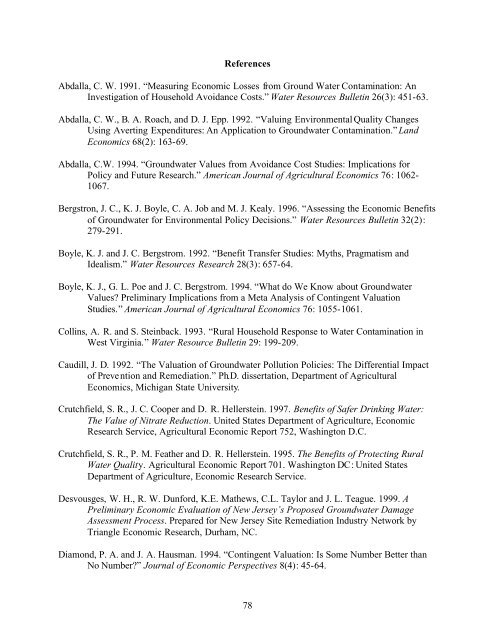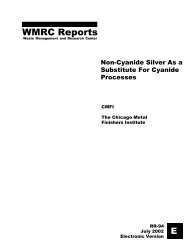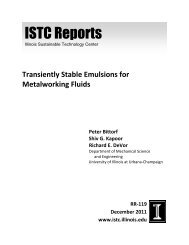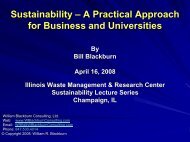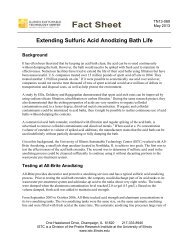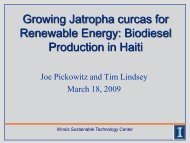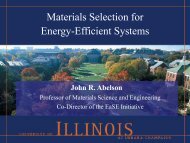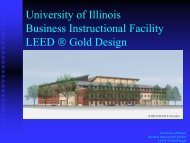Natural Resource Damage Assessment: Methods and Cases
Natural Resource Damage Assessment: Methods and Cases
Natural Resource Damage Assessment: Methods and Cases
You also want an ePaper? Increase the reach of your titles
YUMPU automatically turns print PDFs into web optimized ePapers that Google loves.
References<br />
Abdalla, C. W. 1991. “Measuring Economic Losses from Ground Water Contamination: An<br />
Investigation of Household Avoidance Costs.” Water <strong>Resource</strong>s Bulletin 26(3): 451-63.<br />
Abdalla, C. W., B. A. Roach, <strong>and</strong> D. J. Epp. 1992. “Valuing Environmental Quality Changes<br />
Using Averting Expenditures: An Application to Groundwater Contamination.” L<strong>and</strong><br />
Economics 68(2): 163-69.<br />
Abdalla, C.W. 1994. “Groundwater Values from Avoidance Cost Studies: Implications for<br />
Policy <strong>and</strong> Future Research.” American Journal of Agricultural Economics 76: 1062-<br />
1067.<br />
Bergstron, J. C., K. J. Boyle, C. A. Job <strong>and</strong> M. J. Kealy. 1996. “Assessing the Economic Benefits<br />
of Groundwater for Environmental Policy Decisions.” Water <strong>Resource</strong>s Bulletin 32(2):<br />
279-291.<br />
Boyle, K. J. <strong>and</strong> J. C. Bergstrom. 1992. “Benefit Transfer Studies: Myths, Pragmatism <strong>and</strong><br />
Idealism.” Water <strong>Resource</strong>s Research 28(3): 657-64.<br />
Boyle, K. J., G. L. Poe <strong>and</strong> J. C. Bergstrom. 1994. “What do We Know about Groundwater<br />
Values? Preliminary Implications from a Meta Analysis of Contingent Valuation<br />
Studies.” American Journal of Agricultural Economics 76: 1055-1061.<br />
Collins, A. R. <strong>and</strong> S. Steinback. 1993. “Rural Household Response to Water Contamination in<br />
West Virginia.” Water <strong>Resource</strong> Bulletin 29: 199-209.<br />
Caudill, J. D. 1992. “The Valuation of Groundwater Pollution Policies: The Differential Impact<br />
of Prevention <strong>and</strong> Remediation.” Ph.D. dissertation, Department of Agricultural<br />
Economics, Michigan State University.<br />
Crutchfield, S. R., J. C. Cooper <strong>and</strong> D. R. Hellerstein. 1997. Benefits of Safer Drinking Water:<br />
The Value of Nitrate Reduction. United States Department of Agriculture, Economic<br />
Research Service, Agricultural Economic Report 752, Washington D.C.<br />
Crutchfield, S. R., P. M. Feather <strong>and</strong> D. R. Hellerstein. 1995. The Benefits of Protecting Rural<br />
Water Quality. Agricultural Economic Report 701. Washington DC: United States<br />
Department of Agriculture, Economic Research Service.<br />
Desvousges, W. H., R. W. Dunford, K.E. Mathews, C.L. Taylor <strong>and</strong> J. L. Teague. 1999. A<br />
Preliminary Economic Evaluation of New Jersey’s Proposed Groundwater <strong>Damage</strong><br />
<strong>Assessment</strong> Process. Prepared for New Jersey Site Remediation Industry Network by<br />
Triangle Economic Research, Durham, NC.<br />
Diamond, P. A. <strong>and</strong> J. A. Hausman. 1994. “Contingent Valuation: Is Some Number Better than<br />
No Number?” Journal of Economic Perspectives 8(4): 45-64.<br />
78


